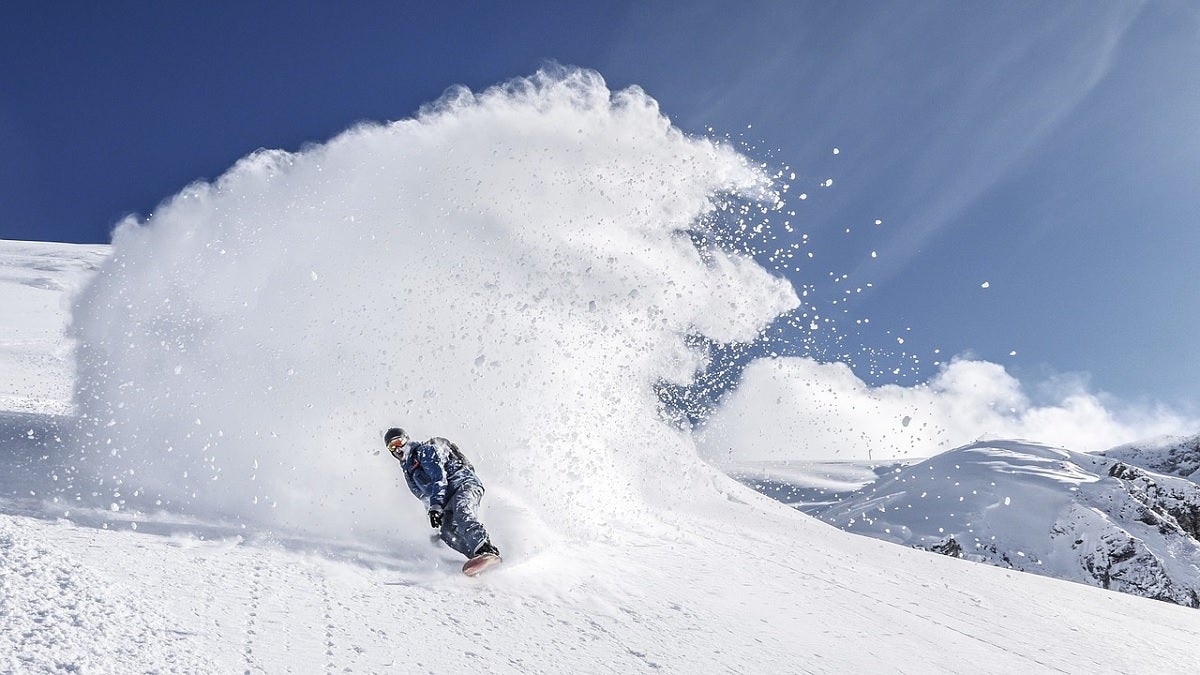
Our Editors independently research, test, and rate what we feel are the best products. We use affiliate links and may receive a small commission on purchases.
If you’re a snowboarding beginner, then you may be feeling confused or even overwhelmed by the different types of boarding and boards. There’s no need to worry, though, because I have you covered! In this brief guide I’m going to take you through them all, so that by the time you’re finished there will be no doubt which is the type of snowboarding is right for your personality, environment, fitness level, and more. I know you want to get started, so let’s dive right in!
1. Alpine
What exactly is alpine snowboarding? Isn’t that just “regular” snowboarding? Not at all! When we’re speaking of “alpine” when talking about boarding, we can refer to both the style and the board used. If you have the need for speed, then you’ll want to stay right here.
Alpine snowboarding is typically performed on very hard snow and/or groomed runs, which are both ideal for achieving high levels of speed. You’ll definitely need to practice more to get really confident at it, though using an alpine snowboard specifically for this boarding niche will greatly help you out.
In many ways, it’s similar to alpine skiing. For example, the boots are much tighter and more rigid as they’re made with a hard shell. These give you more leveraging power and are essentially an extension of your legs, making turning much snappier and intuitive. Ultimately, if you want to go faster with incredible cornering, nothing can beat alpine snowboarding.
2. Freestyle
Snowboarding has a direct connection to skateboarding in both style and attitude, but this is most obvious in freestyle snowboarding. Freestyle is a bit of a general term, but it usually places a special focus on “catching air” and performing tricks. There are even freestyle competitions which are quite popular to watch and typically takes place in a halfpipe or “superpipe” which are professionally made, larger halfpipes.
Freestyle boards are much more flexible and “soft”, with a twin tip and a less extreme side cut which works well in most parks and ramps. As they’re more lightweight, they’re perfect for freestyle and park boarding.
3. Park
Park boarding can be considered to be a niche within freestyle snowboarding and is performed in actual snow parks or environments like gaps, staircases, rails, and so on. Park boarding will require the same type of board that have a soft to medium flex which facilitates jibbing, spins, jumps, and more. They’re typically available in many different flexes and camber profiles, letting you choose a rail specific or jump specific style.
So, what’s the difference between rail and jump boards?
The former feature softer flex patterns while jump boards are incredibly responsive and almost springy to help with impact on harder landings and surfaces. The stance of a park board should be set right over the center of the board as well for best results. This type of snowboarding is typically reserved for more experienced riders as you are putting yourself at a greater risk and it requires a great amount of skill to be able to land these tricks.
4. Powder
You always hear about people chasing the “pow” and there are plenty of reasons why! Snowboarding in fresh powder is not only some of the most fun you can have but is also one of the most breathtaking experiences. It’s almost like surfing on snow, or like gliding effortlessly through butter.
While advanced boarders can take full advantage of riding on powder, beginners tend to love it too! As it’s not packed down or icy, it takes some of the impact away when you fall, and you may even feel more confident riding at higher speeds.
Of course, if you’re going to make it a regular thing, you may want to consider a change of equipment. Powder boards are skilled at floating in deeper snow instead of sinking. They also help add stability so you can ride at these higher speeds, improving edge hold as well. These boards typically come with larger noses, more tapered tails and a set back stance.
5. Backcountry
Finally, we made it to backcountry! This is a type of boarding that should only be done by the most experienced boarders and is undoubtedly the most risky as well. But with great risk comes great reward, and backcountry snowboarding pays dividends in the form of incredible vistas, remoteness, hidden caches of powder, cliffs, and the thrill in itself.
However, due to the nature of the backcountry, avalanches are a very real danger that you must be aware of. The land and snowpack are not typically monitored, patrolled, or maintained so you just have to go on your own knowledge of the area and your intuition. Tree wells are also something that can be life-threatening if you’re not careful. Also known as a spruce trap, this is the area under/around a tree which doesn’t receive the same kind of snowfall as the surrounding open area.
Summary
While there are quite a few different styles of snowboarding, the great thing is you don’t have to settle on just one. It’s common for boarders to start out one way and end up going to another style in the end due to their personal preferences and skills they develop as time progresses. No matter which you choose, make sure you’re not taking on too much, too quickly. Snowboarding must still be approached with proper precautions and awareness.
We hope our guide has helped inform you of the various snowboarding styles. No matter what, remember having fun and being safe is most important. Thanks for tuning in and we’ll see you again shortly!
